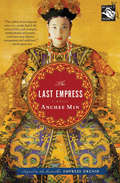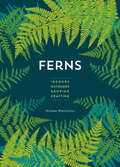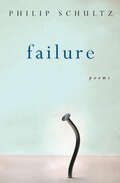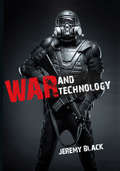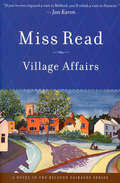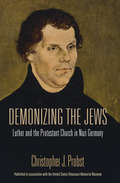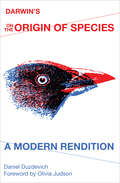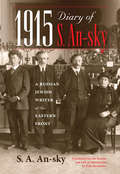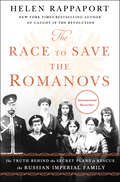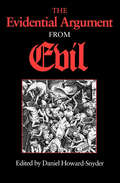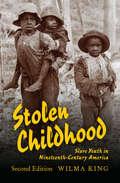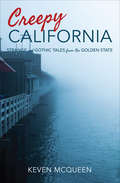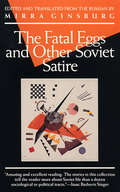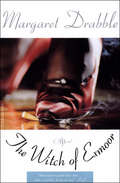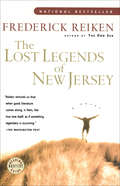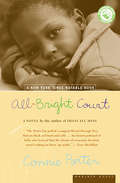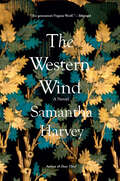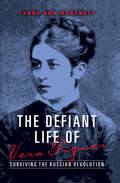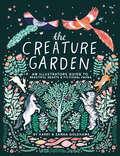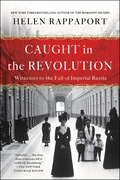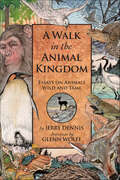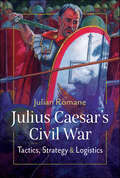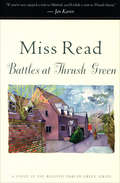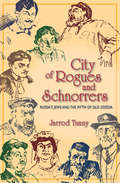- Table View
- List View
The Last Empress: A Novel
by Anchee Min&“Admirers of Empress Orchid will be interested in this sequel. Others may find the introduction to relatively modern Chinese history a revelation&” (Rocky Mountain News). During the tumultuous end of the nineteenth century in China, the only constant was the power wielded by one person: the resilient, ever-resourceful Tzu Hsi, Lady Yehonala—or Empress Orchid—as readers came to know her in Anchee Min&’s critically acclaimed novel covering the first part of her life. In The Last Empress, Orchid moves from the intimacy of the concubine quarters into the spotlight of the world stage. Devastating personal losses take their toll, leaving her yearning to step aside, but only she—allied with the progressives, but loyal to the conservative Manchu clan of her dynasty—can hold the nation&’s rival factions together. Anchee Min offers a powerful revisionist portrait based on extensive research of one of the most important figures in Chinese history. Viciously maligned by the western press of the time as the &“Dragon Lady,&” a manipulative, blood-thirsty woman who held onto power at all costs, the woman Min gives us is a compelling, very human leader who assumed power reluctantly, and who sacrificed all she had to protect those she loved and an empire that was doomed to die. &“The vision of an empress who very nearly had it all: vulnerability and strength, motherhood and power, earthiness and dignity, compassion and ambition.&” —The Washington Post &“Invokes the intrigue and opulence of nineteenth-century China while telling the story of its improbably dominant ruler.&” —Los Angeles Times
Ferns: Indoors - Outdoors - Growing - Crafting
by Mobee WeinsteinA concise, creative, practical guide to growing these amazing plants, drawn from the award-winning volume The Complete Book of Ferns.A more concise version of The Complete Book of Ferns, focused on practical use for gardeners, Ferns offers botanical information, indoor and outdoor growing and care information, details on propagation, display ideas, and even craft projects. With numerous color photos, it will help you add a new dimension to your home or backyard garden reflecting the beauty and wide variety of this hardy plant that dates back to before the time of the dinosaurs.Acclaim for The Complete Book of FernsWinner of an American Horticultural Society Book Award“A lovely and multifaceted exploration . . . as useful as it is educational.” —Publishers Weekly
There's a Riot Going On: Revolutionaries, Rock Stars, and the Rise and Fall of the 60s
by Peter Doggett&“Doggett&’s encyclopaedic account of Sixties counter-culture is a fascinating history of pop&’s relationship with politics.&” —The Independent Between 1965 and 1972, political activists around the globe prepared to mount a revolution. While the Vietnam War raged, calls for black power grew louder and liberation movements erupted everywhere from Berkeley, Detroit, and Newark to Paris, Berlin, Ghana, and Peking. Rock and soul music fueled the revolutionary movement with anthems and iconic imagery. Soon the musicians themselves, from John Lennon and Bob Dylan to James Brown and Fela Kuti, were being dragged into the fray. From Mick Jagger&’s legendary appearance in Grosvenor Square standing on the sidelines and snapping pictures, to the infamous incident during the Woodstock Festival when Pete Townshend kicked yippie Abbie Hoffman off the stage while he tried to make a speech about an imprisoned comrade, Peter Doggett unravels the truth about how these were not the &“Street Fighting Men&” they liked to see themselves as and how the increasing corporatization of the music industry played an integral role in derailing the cultural dream. There&’s a Riot Going On is a fresh, definitive, and exceedingly well-researched behind-the-scenes account of this uniquely turbulent period when pop culture and politics shared the world stage with mixed results. &“A fresh and near-definitive slant on a subject you might have thought had been picked clean by journalists and historians.&” —Time Out London &“An extraordinary book . . . Doggett emerges triumphant. Grab a copy—by any means necessary.&” —Mojo
Failure: Poems
by Philip SchultzA Pulitzer Prize–winning poetry collection of &“heartbreaking tenderness&” (Gerald Stern). A driven immigrant father; an old poet; Isaac Babel in the author&’s dreams: Philip Schultz gives voice to failures in poems that are direct and wry. He evokes other lives, too—family, beaches, dogs, the pleasures of marriage, the terrors of 9/11, New York City in the 1970s (&“when nobody got up before noon, wore a suit/or joined anything&”)—and a mind struggling with revolutions both interior and exterior. Failure is a superb collection, &“full of slashing language, good rhythms [and] surprises&” (Norman Mailer). &“Philip Schultz&’s poems have long since earned their own place in American poetry. His stylistic trademarks are his great emotional directness and his intelligent haranguing—of god, the reader, and himself. He is one of the least affected of American poets, and one of the fiercest.&” —Tony Hoagland
War and Technology: Society, Technology, And War From Ancient Times To The Present (Encounters: Explorations in Folklore and Ethnomusicology)
by Jeremy Black&“[A] scholarly overview of military technology throughout history—starting roughly in the 15th century and extending into the future . . . insightful.&”—Publishers Weekly In this engaging book, Jeremy Black argues that technology neither acts as an independent variable nor operates without major limitations. This includes its capacity to obtain end results, as technology&’s impact is far from simple and its pathways are by no means clear. After considering such key conceptual points, Black discusses important technological advances in weaponry and power projection from sailing warships to aircraft carriers, muskets to tanks, balloons to unmanned drones—in each case, taking into account what difference these advances made. He addresses not only firepower but also power projection and technologies of logistics, command, and control. Examining military technologies in their historical context and the present centered on the Revolution in Military Affairs and Military Transformation, Black then forecasts possible future trends. &“Clear, concise, and thoughtful. An eminently readable synthesis of historical literature on technology and war.&”—John France, author of Perilous Glory: The Rise of Western Military Power &“An interesting, thought provoking work by a major military historian . . . whose depth and wide range of knowledge across the entire sweep of world military history is without parallel.... Those who read this book closely will be richly rewarded for it is a mine of useful information and grist for discussion.&”—Spencer C. Tucker, author of The European Powers in the First World War &“A most useful introduction to a very complex subject, and particularly valuable for its notes and references to other works. Provocative and vigorously argued . . . Highly recommended.&”—Choice
Village Affairs: A Novel (The Beloved Fairacre Series #13)
by Miss Read&“Delicious wit, quirky characters, [and] the colorful intrigues of daily life&” make Fairacre America&’s favorite English village (Jan Karon, #1 New York Times–bestselling author). The English village of Fairacre may appear idyllically peaceful to passersby, but those who live among its shady lanes always have problems to untangle. When a terrible rumor emerges—that the Fairacre School is to be closed and the children bused to nearby Beech Green—the village is up in arms at once. The schoolmistress, Miss Read, suffers agonizing indecision at the prospect, and her situation is made worse when her infants&’ teacher decides to leave and the short-tempered Mrs. Pringle becomes more contrary than ever. &“Affectionate, humorous, and gently charming . . . Sometimes funny, sometimes touching, always appealing.&” —The New York Times &“Miss Read reminds us of what is really important. And if we can&’t live in her world, it&’s certainly a comforting place to visit.&” —USA Today
Demonizing the Jews: Luther and the Protestant Church in Nazi Germany
by Christopher J. Probst&“An insightful analysis of the ways in which Protestant reformer Martin Luther&’s anti-Jewish writings were used by German Protestants during the Third Reich.&” —Contemporary Church History Quarterly The acquiescence of the German Protestant churches in Nazi oppression and murder of Jews is well documented. In this book, Christopher J. Probst demonstrates that a significant number of German theologians and clergy made use of the 16th-century writings by Martin Luther on Jews and Judaism to reinforce the racial antisemitism and religious anti-Judaism already present among Protestants. Focusing on key figures, Probst&’s study makes clear that a significant number of pastors, bishops, and theologians of varying theological and political persuasions employed Luther&’s texts with considerable effectiveness in campaigning for the creation of a &“de-Judaized&” form of Christianity. Probst shows that even the church most critical of Luther&’s anti-Jewish writings reaffirmed the antisemitic stereotyping that helped justify early Nazi measures against the Jews. &“A valuable contribution to our understanding of the churches under Nazism.&” —Lutheran Quarterly &“An insightful account of the convoluted echoes and reverberations of this deeply problematic aspect of Luther&’s legacy within German Protestantism over the longue durée.&” —German Studies Review
Darwin's On the Origin of Species: A Modern Rendition
by Daniel DuzdevichAn essential new edition of the 19th-century scientific masterpiece that translates Darwin&’s Victorian prose into modern English: &“Most useful&” (Walter Brock, Columbia University). Charles Darwin&’s most famous book On the Origin of Species is without question one of the most important books ever written. Yet many students have great difficulty understanding it. While even the grandest works of Victorian English can be a challeng for modern readers, Darwin&’s dense scientific prose is especially difficult to navigate. For an era in which Darwin is more talked about than read, doctoral student Daniel Duzdevich offers a clear, modern English rendering of Darwin&’s first edition. Neither an abridgement nor a summary, this version might best be described as a translation for contemporary English readers. A monument to reasoned insight, the Origin illustrates the value of extensive reflection, carefully gathered evidence, and sound scientific reasoning. By removing the linguistic barriers to understanding and appreciating the Origin, this edition brings 21st-century readers into closer contact with Darwin&’s revolutionary ideas.
1915 Diary of S. An-sky: A Russian Jewish Writer at the Eastern Front (Encounters: Explorations in Folklore and Ethnomusicology)
by S. A. An-SkyThe WWI diary of the Russian Jewish activist and author of The Dybbuk presents &“an unforgettable portrait of life, culture, and destruction&” (Eugene Avrutin, author of Jews and the Imperial State). By the outbreak of World War I, S. An-sky was a well-known writer, a longtime revolutionary, and an ethnographer who pioneered the collection of Jewish folklore in Russia's Pale of Settlement. In 1915, An-sky took on the assignment of providing aid and relief to Jewish civilians trapped under Russian military occupation in Galicia. As he made his way through the shtetls there, close to the Austrian frontlines, he kept a diary of his encounters and impressions. In his diary, An-sky describes conversations with wounded soldiers in hospitals, fellow Russian and Jewish aid workers, and Jewish civilians living on the Eastern Front. He recorded the brutality and violence against the civilian population, the complexities of interethnic relations, the practices and limitations of philanthropy and medical care, Russification policies, and antisemitism. In the late 1910s, An-sky used his diaries as raw material for a lengthy memoir in Yiddish, published under the title The Destruction of Galicia. Although most of An-sky&’s original diaries were lost, two fragments are preserved in the Russian State Archive of Literature and Art. Translated and annotated here by Polly Zavadivker, these fragments convey An-sky's vivid perceptions and enlightening insights.
The Race to Save the Romanovs: The Truth Behind the Secret Plans to Rescue the Russian Imperial Family
by Helen RappaportIn this international bestseller investigating the murder of the Russian Imperial Family, Helen Rappaport embarks on a quest to uncover the various plots and plans to save them, why they failed, and who was responsible.The murder of the Romanov family in July 1918 horrified the world, and its aftershocks still reverberate today. In Putin's autocratic Russia, the Revolution itself is considered a crime, and its anniversary was largely ignored. In stark contrast, the centenary of the massacre of the Imperial Family was commemorated in 2018 by a huge ceremony attended by the Patriarch of the Russian Orthodox Church.While the murders themselves have received major attention, what has never been investigated in detail are the various plots and plans behind the scenes to save the family—on the part of their royal relatives, other governments, and Russian monarchists loyal to the Tsar. Rappaport refutes the claim that the fault lies entirely with King George V, as has been the traditional view for the last century. The responsibility for failing the Romanovs must be equally shared. The question of asylum for the Tsar and his family was an extremely complicated issue that presented enormous political, logistical and geographical challenges at a time when Europe was still at war. Like a modern day detective, Helen Rappaport draws on new and never-before-seen sources from archives in the US, Russia, Spain and the UK, creating a powerful account of near misses and close calls with a heartbreaking conclusion. With its up-to-the-minute research, The Race to Save the Romanovs is sure to replace outdated classics as the final word on the fate of the Romanovs.
The Evidential Argument from Evil (Indiana Series in the Philosophy of Religion)
by William L. Rowe Eleonore Stump Alvin Plantinga William P. Alston Richard M. Gale Paul Draper Peter van Inwagen Richard Swinburne Bruce Russell Stephen J. WykstraIs evil evidence against the existence of God? A collection of essays by philosophers, theologians, and other scholars. Even if God and evil are compatible, it remains hotly contested whether evil renders belief in God unreasonable. The Evidential Argument from Evil presents five classic statements on this issue by eminent philosophers and theologians, and places them in dialogue with eleven original essays reflecting new thinking by these and other scholars. The volume focuses on two versions of the argument. The first affirms that there is no reason for God to permit either certain specific horrors or the variety and profusion of undeserved suffering. The second asserts that pleasure and pain, given their biological role, are better explained by hypotheses other than theism. Contributors include William P. Alston, Paul Draper, Richard M. Gale, Daniel Howard-Snyder, Alvin Plantinga, William L. Rowe, Bruce Russell, Eleonore Stump, Richard G. Swinburne, Peter van Inwagen, and Stephen John Wykstra.
Stolen Childhood: Slave Youth in Nineteenth-Century America (Blacks in the Diaspora)
by Wilma KingAn updated edition of the classic study that took &“an enormous step toward filling some of the voids in the literature of slavery&” (The Washington Post Book World).One of the most important books published on slave society, Stolen Childhood focuses on the millions of children and youth enslaved in 19th-century America. This enlarged and revised edition reflects the abundance of new scholarship on slavery that has emerged.Wilma King has expanded its scope to include the international dimension with a new chapter on the transatlantic trade in African children, and the book&’s geographic boundaries now embrace slave-born children in the North. She includes data about children owned by Native Americans and African Americans, and presents new information about children&’s knowledge of and participation in the abolitionist movement and the interactions between enslaved and free children. &“A jarring snapshot of children living in bondage. This compellingly written work is a testament to the strength and resilience of the children and their parents.&”—Booklist on the first edition
Creepy California: Strange and Gothic Tales from the Golden State
by Keven McQueenThis &“fun primer on California&’s macabre and eccentric history&” explores true crimes, paranormal reports, and other curious tales from the Pacific Coast (Paul Koudounaris). California has many famous wonders—the beaches, vineyards, and glamorous neighborhoods are all well documented in guidebooks. But there are darker wonders here as well—the kind seldom shared with outsiders. In Creepy California historian Kevin McQueen explores strange tales of unexplained deaths, intentional live burials, true crimes, and ghosts who haunt the Pacific Coast. From the uncanny to the outright paranormal, this chronicle of oddities includes the story of a coroner who &“borrowed&” the stylish clothes of a dead man and then sold the corpse&’s head to a doctor; a rare look inside Stanford University&’s secret collection of occult memorabilia; the tale of a haunted, two-story house in San Francisco that was painstakingly moved across town in an effort to dislodge its ghostly tenants; a profile of a lonesome Fort Bragg resident who carved a family for himself out of wood; and many others. An intriguing look at the Golden State&’s bounty of unsettling curiosities, Creepy California promises to keep you guessing what other mysteries lurk in the fog.
The Fatal Eggs and Other Soviet Satire (Quartet Encounters Ser.)
by Mirra GinsburgThe classic collection of wildly inventive and bitingly satirical tales of post-revolutionary Russia: &“amusing and excellent reading&” (Isaac Bashevis Singer). This famous collection of Soviet satire from 1918 to 1963 devastatingly lampoons the social, economic, and cultural changes wrought by the Russian Revolution. Among the seventeen boldly outspoken writers represented here are Mikhail Bulgakov, Ilya Ilf, Yevgeny Petrov, Mikhail Zoshchenko, Yevgeny Zamyatin, Valentin Katayev, and Yury Kazakov. Whether the stories and novellas collected here take the form of allegory, fantasy, or science fiction, the results are ingenious, critical, and hilariously timeless. &“The stories in this collection tell the reader more about Soviet life than a dozen sociological or political tracts.&” —Isaac Bashevis Singer &“An altogether admirable collection . . . by the highly talented translator Mirra Ginsburg . . . Many of these stories and sketches are delicious, even—a miracle!—funny, and full of subtlety and intelligence.&” —The New Leader &“Hilarious entertainment. Beyond this it illuminates with the cruel light of satire the reality behind the pretentious façade of the Soviet state.&” —Sunday Sun
The Witch of Exmoor (Isis Series)
by Margaret DrabbleA Los Angeles Times Best Book of the Year: &“Part social satire, part thriller, and entirely clever&” (Elle). It is a midsummer&’s evening in the English countryside, and the three grown Palmer children are coming to the end of an enjoyable meal in the company of their partners and offspring. From this pleasant vantage point they play a dinner-party game: What kind of society would you be willing to accept if you didn&’t know your place in it? But the abstract question of justice, like all their family conversations, is eventually brought back to the more pressing problem of their eccentric mother, Frieda, the famous writer, who has abandoned them and her old life, and gone to live alone in Exmoor. Frieda has always been a powerful and puzzling figure, a monster mother with a mysterious past. What is she plotting against them now? Has some inconvenient form of political correctness led her to favor her enchanting half-Guyanese grandson? What will she do with her money? Is she really writing her memoirs? And why has she disappeared? Has the dark spirit of Exmoor finally driven her mad? The Witch of Exmoor brilliantly interweaves high comedy and personal tragedy, unraveling the story of a family whose comfortable, rational lives, both public and private, are about to be violently disrupted by a succession of sinister, messy events. &“Leisurely and mischievous,&” it is a dazzling, wickedly gothic tale of a British matriarch, her three grasping children, and the perils of self-absorption (The New Yorker). &“As meticulous as Jane Austen, as deadly as Evelyn Waugh.&” —Los Angeles Times
The Lost Legends of New Jersey
by Frederick ReikenIn Reiken’s “affectionate but tough-minded second novel, he captures the poetry of the New Jersey condition, circa 1980, with a rare precision” (The New York Times Book Review).A New York Times Notable Book of the YearA Los Angeles Times Best Book of the YearRomeo and Juliet in northern New Jersey? Yiddish constellations in Asbury Park? A garbage dump in the Meadowlands that’s filled with old musical instruments from a high school marching band? Love and sex, hockey and snorkeling, a family that is falling apart despite the best intentions—this is what Frederick Reiken has delivered in his brilliant second novel.But the real subject is true love, the one and only—known in Yiddish as b’shert. Anthony Rubin, the young protagonist, isn’t sure whether he’s found it with his neighbor, Juliette, daughter of a reputed Mafioso. His mother, who quits the family after her husband’s affair with a neighbor, doesn’t believe in true love at all. But his father does, and so does Anthony’s grandpa, who meets the love of his life at 78.Reiken is known for creating characters you feel you’ve known all your life, for mapping landscapes with profound intimacy and wonder. In The Lost Legends of New Jersey, he “reminds us that when good literature comes along, it feels, like true love itself, as if something legendary is occurring” (The Washington Post).“A beautifully told story of bad choices, good intentions, and the price of intimacy.” —Chicago Tribune“Reiken has created a rich, seductive mythology out of the ordinary places and people of the Garden State.” —Los Angeles Times
All-Bright Court: A Novel
by Connie PorterA New York Times Notable Book: A novel spanning two decades in the lives of an African American family as their upstate New York steel town slowly decays. Set just outside Buffalo, New York, during the 1960s and &’70s, All-Bright Court paints a portrait of the Taylor family—starting with hopeful dreams as Samuel Taylor and his wife, Mary Kate, migrate from the South looking for better opportunities and a place to raise a family, and continuing through the decline of the steel industry as they, their five children, and their neighbors on All-Bright Court struggle with both new challenges and old prejudices. &“In a clear, quiet but powerful prose reminiscent of Sherwood Anderson&’s Winesburg, Ohio, the author draws the gaudily painted, rundown bungalows of All-Bright Court and peoples it convincingly. . . . The working conditions in the steel mills and the politics of the union hall are well rendered, but it is in the details of family life that the novel comes alive.&” —Kirkus Reviews &“Porter has mapped a rich fictional world. . . . This is a powerful and affecting debut.&” —Michiko Kakutani, The New York Times &“An honest portrayal of folks who learned that the dream of economic freedom wasn&’t waiting for them &‘up north.&’&” —Terry McMillan, New York Times–bestselling author of I Almost Forgot About You
The Western Wind: A Novel
by Samantha HarveyFrom the Booker Prize-winning author of Orbital, &“a beautifully written . . . medieval mystery packed with intrigue, drama and shock revelations&” (Minneapolis Star-Tribune). Acclaimed as &“one of the UK&’s most exquisite stylists&” by The Guardian and &“this generation&’s Virginia Woolf&” by The Telegraph, Samantha Harvey has penned an extraordinary novel of faith, guilt, and the freedom of confession. It&’s 1491. In the small village of Oakham, its wealthiest and most industrious resident, Tom Newman, is swept away by the river during the early hours of Shrove Saturday. Was it murder, suicide, or an accident? Narrated from the perspective of local priest John Reve—patient shepherd to his wayward flock—a shadowy portrait of the community comes to light through its residents&’ tortured revelations. As some of their darkest secrets are revealed, the intrigue of the unexplained death ripples through the congregation. But will Reve, a man with secrets of his own, discover what happened to Newman? And what will happen if he can&’t? Written with timeless eloquence, steeped in the spiritual traditions of the Middle Ages, and brimming with propulsive suspense, The Western Wind finds Samantha Harvey at the pinnacle of her outstanding novelistic power.&“Beautifully rendered, deeply affecting, thoroughly thoughtful and surprisingly prescient . . . a story of a community crowded with shadows and secrets.&” —The New York Times Book Review&“Ms. Harvey has summoned this remote world with writing of the highest quality, conjuring its pungencies and peculiarities.&” —The Wall Street Journal&“Brings medieval England back to life.&” —The Washington Post
The Defiant Life of Vera Figner: Surviving the Russian Revolution (Encounters: Explorations in Folklore and Ethnomusicology)
by Lynne Ann HartnettA &“riveting&” biography of a Russian noblewoman turned revolutionary terrorist and accomplice in the assassination of a tsar (The Soviet and Post-Soviet Review). Born in 1852 in the last years of serfdom, Vera Figner came of age as Imperial Russian society was being rocked by the massive upheaval that culminated in the Bolshevik revolution of 1917. At first a champion of populist causes and women&’s higher education, which she herself pursued as a medical student in Zurich, Figner later became a leader of the terrorist party the People&’s Will—and was an accomplice in the assassination of Tsar Alexander II in 1881. Drawing on extensive archival research and careful reading of Figner&’s copious memoirs, Lynne Ann Hartnett reveals how Figner survived the Bolshevik revolution and Stalin's Great Purges and died a lionized revolutionary legend as the Nazis bore down on Moscow in 1942.
The Creature Garden: An Illustrator's Guide to Beautiful Beasts & Fictional Fauna
by Harry Goldhawk Zanna GoldhawkAn illustrator’s step-by-step sourcebook for drawing and painting fifty real and imagined creatures in a whimsical folk-art style. Husband-and-wife illustrator team Harry and Zanna Goldhawk, founders of Papio Press, teach you how to make vibrant drawings and paintings of these beautiful beasts and fictional fauna:Mammals, including big cats, wolves, sloths, and red pandasMarine life, including whales, sea dragons, narwhals, and giant Pacific octopiBirds, including peacocks, cranes, owls, and flamingosInsects, including butterflies, moths, bumblebees, and damselfliesMythical creatures, including mermaids, unicorns, dragons, phoenixes, centaurs, and hippogriffsand more!The Creature Garden begins with the basics, first instructing you on which tools to use, how to create patterns, the importance of keeping a sketchbook, and even avoiding comparison with other artists. The book then navigates through each illustration in a step-by-step manner that is manageable and easy to understand. Each project carefully guides you through each phase of the artistic process, from creating an outline to adding a realistic animal pattern.You’ll also learn how to draw botanical patterns from different environments—the garden, forest, jungle, and ocean—that enable you to surround your animal drawings with a natural environment. Full of lush warmth and fairy-tale wonder, The Creature Garden is a wonderful addition to the repertoire of both seasoned artists and novices alike.
Caught in the Revolution: Witness to the Fall of Imperial Russia
by Helen RappaportFrom the New York Times bestselling author of The Romanov Sisters, Caught in the Revolution is Helen Rappaport's masterful telling of the outbreak of the Russian Revolution through eye-witness accounts left by foreign nationals who saw the drama unfold.Between the first revolution in February 1917 and Lenin’s Bolshevik coup in October, Petrograd (the former St Petersburg) was in turmoil – felt nowhere more keenly than on the fashionable Nevsky Prospekt. There, the foreign visitors who filled hotels, clubs, offices and embassies were acutely aware of the chaos breaking out on their doorsteps and beneath their windows.Among this disparate group were journalists, diplomats, businessmen, bankers, governesses, volunteer nurses and expatriate socialites. Many kept diaries and wrote letters home: from an English nurse who had already survived the sinking of the Titanic; to the black valet of the US Ambassador, far from his native Deep South; to suffragette leader Emmeline Pankhurst, who had come to Petrograd to inspect the indomitable Women’s Death Battalion led by Maria Bochkareva.Helen Rappaport draws upon this rich trove of material, much of it previously unpublished, to carry us right up to the action – to see, feel and hear the Revolution as it happened to an assortment of individuals who suddenly felt themselves trapped in a "red madhouse."
A Walk in the Animal Kingdom: Essays on Animals Wild and Tame (The Wonders of Nature)
by Jerry DennisAnimals are everywhere in our lives. We follow them into the wild, we invite them into our homes, they inhabit our dreams, mythologies, folklores, and popular cultures. What is this powerful bond? Why are we so fascinated with animals of every kind? And why has our relationship with them always been riddled with such complexity and contradiction?A Walk in the Animal Kingdom explores the world of animals with the inquisitiveness, depth, and gentle humor that readers across the globe have come to expect from the acclaimed author-artist team of Jerry Dennis and Glenn Wolff. The book is an inquiry into animals of the world, their astonishing diversity and abundance; their mating habits, defensive strategies, and other behaviors; their extraordinary senses of sight, hearing, and smell. It is also an exploration of our profound connection with them, from the joys they inspire and the fears they arouse, to their prominence in our lives as pets, team mascots, and embodiments of wild nature—and the paradox that allows us to battle to protect certain species while ignoring others that are disappearing at a rate perhaps unequaled in the history of our planet. Like the previous collaborations of Dennis and Wolff, A Walk in the Animal Kingdom is certain to become a classic among books about nature—its wonders, its complexities, and our place in it.
Julius Caesar's Civil War: Tactics, Strategies & Logistics
by Julian RomaneJulian Romane examines the campaigns of Julius Caesar throughout the civil wars that followed his famous crossing of the Rubicon, through to the defeat of the final Pompeian diehards at the battle of Munda. He analyzes Caesar's generalship in the widest sense, with a strong emphasis on the logistical and financial effort required to put his legions in the field and keep them equipped, fed and paid. The attention given to this important but often-neglected aspect sets this account apart from many others. The author discusses the nature of late Republican Roman armies, describing their organization, tactics and equipment. The fact that such armies were employed both by and against Caesar only emphasizes the role of generalship in the outcome. This is followed by a detailed account of the strategic maneuvers in Caesar's epochal duel with Pompey the Great and the resultant battles at Dyrrhachium and Pharsalus. The final campaigns to mop up opposition in Spain and Africa are studied in equal detail to give a complete picture of Caesar's command performance in these history-shaping events.
Battles at Thrush Green: A Novel (The Beloved Thrush Green Series #4)
by Miss ReadA new season brings changes—and hope—to the little English village of Thrush Green, from the beloved author of the Fairacre series. Nestled in the heart of the Cotswolds, Thrush Green is normally a peaceful place. But as autumn turns to winter, feelings are running high in the village. Miss Fogerty, a respected teacher at the village school for over thirty years, is troubled by the methods of the new young teacher. Dotty Harmer takes up driving, much to the concern of others, and it isn&’t long before she is involved in an accident and a threatening court case. And when the good rector innocently suggests the neglected churchyard should be tidied up, Thrush Green is outraged. It seems wherever you look, there are difficulties and changes, but as spring arrives, there is renewed hope that all will end well. &“Thrush Green is a village somewhere on the road between Lulling and Nod. Nonetheless, there is nothing sleepy about the place. No indeed. In this delicious installment, there are &‘battles&’ erupting all over. . . . [Miss Read] has plenty of grist here for the village mill. You can&’t get farther away from the front page than this.&” —The New York Times
City of Rogues and Schnorrers: Russia's Jews and the Myth of Old Odessa
by Jarrod Tanny&“Outstanding . . . A delightfully written work of serious scholarship.&” —Jewish Book World Old Odessa, on the Black Sea, gained notoriety as a legendary city of Jewish gangsters and swindlers, a frontier boomtown mythologized for the adventurers, criminals, and merrymakers who flocked there to seek easy wealth and lead lives of debauchery and excess. Odessa is also famed for the brand of Jewish humor brought there in the nineteenth century from the shtetls of Eastern Europe and that flourished throughout Soviet times. From a broad historical perspective, Jarrod Tanny examines the hybrid Judeo-Russian culture that emerged in Odessa in the nineteenth century and persisted through the Soviet era and beyond. The book shows how the art of eminent Soviet-era figures such as Isaac Babel, Il&’ia Ilf, Evgenii Petrov, and Leonid Utesov grew out of the Odessa Russian-Jewish culture into which they were born and which shaped their lives. &“Traces the emergence, development, and persistence of the myth of Odessa as both Garden of Eden and Gomorrah . . . A joy to read.&” —Robert Weinberg, Swarthmore College
